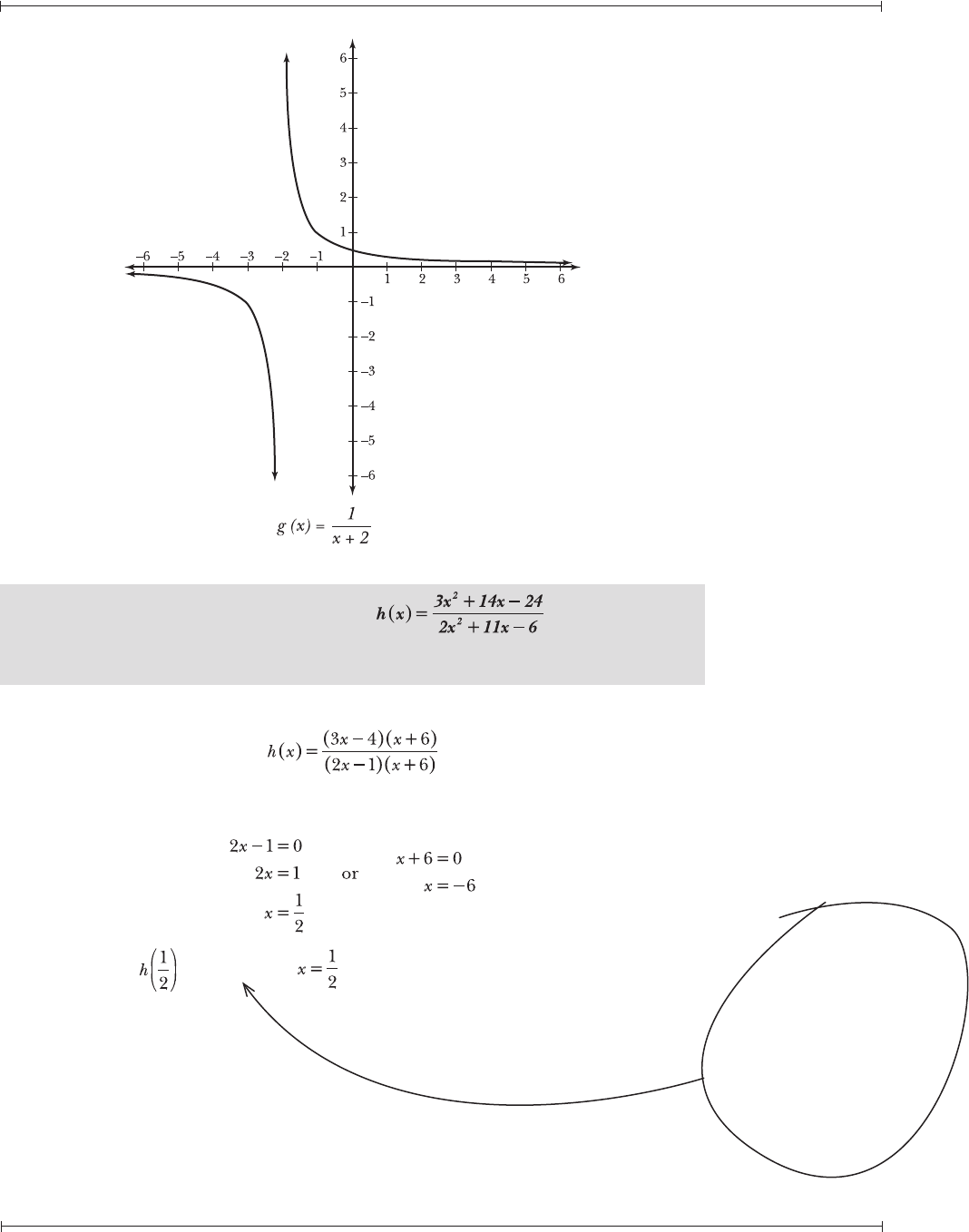
Chapter Twenty — Rational Expressions
The Humongous Book of Algebra Problems
459
Reduce the fraction to lowest terms.
20.34 Simplify the complex fraction: .
Express the complex fraction as a quotient.
Factor the quadratic expressions and simplify the product.
Graphing Rational Functions
Rational functions have asymptotes
20.35 Given a function , describe how to identify the vertical and
horizontal asymptotes of its graph.
If x = c is a vertical asymptote of the graph, then d(c) = 0 but n(c) ≠ 0. To
determine the horizontal asymptotes of f(x), if any exist, consider the degrees
of the numerator and denominator. Let a be the degree of n(x) and b represent
the degree of d(x).
You can’t
cancel out the
x’s here to get
, because x and
–7 aren’t multiplied in
the denominator.
Set the
denominator
equal to zero
and solve. The
solutions represent
vertical asymptotes as
long as they don’t also
make the numerator
equal 0 when you
plug them into
n(x).

Chapter Twenty — Rational Expressions
The Humongous Book of Algebra Problems
460
◆ If a > b, then f(x) has no horizontal asymptotes.
◆ If a < b, then the y-axis is the horizontal asymptote of f(x).
◆ If a = b, then the horizontal asymptote of f(x) is
.
Note: Problems 20.36–20.38 refer to the function .
20.36 Identify the vertical asymptote to the graph of g(x).
Set the denominator of g(x) equal to 0 and solve for x.
The line x = –2 is a vertical asymptote to the graph of g(x) because g(–2) is
undefined.
Note: Problems 20.36–20.38 refer to the function .
20.37 Identify the horizontal asymptote to the graph of g(x).
The degree of the numerator of g(x) is 0, and the degree of the denominator is
1. According to Problem 20.35, when the degree of the numerator is less than
the degree of the denominator, the y-axis, g(x) = 0, is the horizontal asymptote
to the graph.
Note: Problems 20.36–20.38 refer to the function .
20.38 Graph g(x).
To transform the function into g(x), you add two to the input of the
function, which shifts the graph of two units to the left. The graph of g(x)
is presented in Figure 20-1.
If the
highest
powers of x in
the numerator
and denominator
are equal, then the
coefcient attached
to the highest power in
the numerator divided
by the coefcient
attached to the
highest power of the
denominator is
the horizontal
asymptote.
A function is
undened when
its denominator
equals zero and its
numerator doesn’t. In
this case,
g(–2) =
.
The highest
power of x in the
denominator is x
1
, so
its degree is 1. There
are no variables in the
numerator, so it has
degree 0.
It’s more correct
to say the equation
of the y-axis is g(x) = 0
i
nstead y = 0, because
technically there aren’t
any y’s in the equation.
Write g(x) where you’d
normally write y.
See Problem
16.34 for more
information.

Chapter Twenty — Rational Expressions
The Humongous Book of Algebra Problems
461
Figure 20-1: The graph of has vertical asymptote x = –2 and horizontal
asymptote g(x) = 0.
Note: Problems 20.39–20.41 refer to the function .
20.39 Identify the vertical asymptote(s) to the graph of h(x).
Factor the numerator and denominator of h(x).
Set the factors of the denominator equal to zero and solve for x.
Because is undefined, is a vertical asymptote to the graph of h(x).
If you plug
x = –6 into h(x), it
makes the numerator
and denominator equal
zero. For x = –6 to be a
vertical asymptote, it has
to make the denominator
equal zero but not the
numerator.

Chapter Twenty — Rational Expressions
The Humongous Book of Algebra Problems
462
Note: Problems 20.39–20.41 refer to the function .
20.40 Identify the horizontal asymptote to the graph of h(x), if one exists.
The numerator and denominator both have degree two. According to Problem
20.35, the horizontal asymptote is the quotient of the leading coefficients of the
numerator and denominator. Therefore, the graph of h(x) has horizontal
asymptote .
Note: Problems 20.39–20.41 refer to the function .
20.41 Use a table of values to plot the graph of h(x).
Construct a table of values that includes x-values near the vertical asymptote,
because the most dramatic changes in the graph of a rational function occur
near its vertical asymptotes.
The graph of h(x) is presented in Figure 20-2.
Plug the
x’s into the
factored version
of h(x) from Problem
20.39. It makes
evaluating the
functions a little
easier.

Chapter Twenty — Rational Expressions
The Humongous Book of Algebra Problems
463
Figure 20-2: The graph of has vertical asymptote
and horizontal asymptote .
Note: Problems 20.42–20.44 refer to the function .
20.42 Identify all horizontal and vertical asymptotes to the graph of f(x).
Because f(–1) is undefined, x = –1 is a vertical asymptote to the graph of f(x).
The graph of f(x) has no horizontal asymptotes because the degree of its
numerator is greater than the degree of its denominator. (See Problem 20.35.)
Note: Problems 20.42–20.44 refer to the function .
20.43 Identify the equation of the oblique asymptote to the graph of f(x).
Divide the denominator x + 1 into the numerator x
2
– 2x + 5 using synthetic or
long division.
Thus, . The equation of the oblique
asymptote is the quotient, omitting the remainder: y = x – 3.
Only rational
functions with
numerators that
are exactly one
degree higher than their
denominators may have
an oblique asymptote,
but not all of them do.
Oblique asymptotes
are sometimes
called “slant
asymptotes.”
..................Content has been hidden....................
You can't read the all page of ebook, please click here login for view all page.
